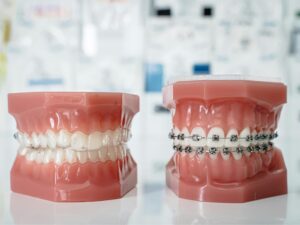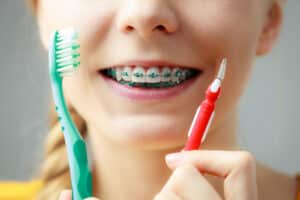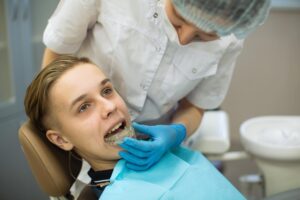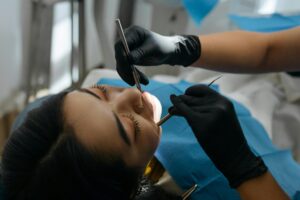If you’re comparing Invisalign for kids in Allentown to traditional braces, you’re not alone. Many parents are trying to determine what works best for their child’s comfort, confidence, and long-term success. Both treatments are effective, but they offer very different experiences. What’s right for one child may not be the right fit for another.
Learn what you need to know so you can feel more confident in your decision. We’ll walk through how each option works, how they compare, and what to consider before making a choice.
How Invisalign for Kids Works and Who It’s For

Invisalign isn’t just for teens and adults anymore. With Invisalign First, younger patients can now benefit from clear aligners designed for growing smiles. This system helps guide jaw and tooth development at an early age, and combined with Invisalign for Kids in Allentown, it offers a comprehensive solution for children and adolescents.
What Is Invisalign First?
Invisalign First is created for children between the ages of 6 and 10. It focuses on early orthodontic treatment, also called Phase 1 treatment. At this stage, a child’s mouth is still developing, which makes it a good time to catch alignment issues early.
This version of Invisalign works by using a series of clear, removable trays that slowly move the teeth into a better position. Each set is custom-made based on 3D scans of your child’s mouth.
Benefits of Invisalign for Younger Patients
Parents considering Invisalign for their kids in Allentown often ask about the Invisalign for children benefits. These are the main advantages:
-
Trays are removable, making it easier to brush and floss
-
No brackets or wires that cause irritation
-
Practically invisible, which may appeal to kids concerned about appearance
-
Fewer emergency visits for broken brackets or poking wires
What Makes a Child a Good Candidate?
Invisalign First works well for kids who:
-
Have mild to moderate spacing or crowding
-
Can follow instructions and wear aligners 20–22 hours a day
-
Don’t have severe bite or jaw issues
-
Have most of their baby teeth gone, or are they close to that stage
It’s always important to consult with an orthodontist to confirm if your child qualifies for this type of treatment. Even though Invisalign offers convenience, it still requires commitment.
What to Know About Braces for Children
Braces have been a trusted choice in orthodontics for decades. They’re reliable, effective, and still widely used for kids with developing teeth and jaws. For many families, braces are the standard approach to correcting a range of dental issues.
Different Types of Braces for Kids
While metal braces are the most common, there are other options designed for comfort and appearance.
Here are a few choices:
-
Traditional metal braces – Strong and effective for complex cases
-
Ceramic braces – Less noticeable with tooth-colored brackets
-
Self-ligating braces – No elastic bands, which can reduce pressure and friction
Each option has its pros and is selected based on your child’s specific needs.
Why Kids Might Need Braces
Braces are often used for more complex alignment or bite issues that aligners may not address as efficiently. They work by using a bracket-and-wire system that puts constant pressure on the teeth over time.
Braces are commonly recommended for:
-
Severe crowding or crooked teeth
-
Overbites, underbites, or crossbites
-
Gaps or spacing problems
-
Issues with jaw development
Because they’re fixed in place, braces don’t rely on the child remembering to wear them. That makes them a solid option for younger kids who may not yet have strong daily habits.
Benefits of Traditional Braces
Parents sometimes worry that braces are outdated, but they’re still one of the most effective tools available. Here’s why they’re still popular:
-
They stay on, which ensures continuous progress
-
They can treat a wide range of alignment issues
-
Regular check-ins help monitor and adjust the treatment closely
-
Often more budget-friendly depending on your insurance
Braces aren’t for everyone, but they remain a dependable solution for many growing smiles. If your child has more advanced alignment needs, this option might be the most effective approach.
Invisalign for Kids Allentown vs. Braces: Key Differences
When choosing between Invisalign and braces, it helps to compare how each option works in daily life. Both can improve your child’s smile, but they do it in different ways. Here’s how they stack up side by side.
1. Comfort and Appearance
-
Invisalign: Smooth plastic aligners reduce irritation. They’re clear, so most people won’t notice them.
-
Braces: Metal brackets can cause soreness, especially after adjustments. They’re visible but come with colour band options, and some kids enjoy.
2. Cleaning and Care
-
Invisalign: Aligners come out for brushing and flossing. This keeps things cleaner, but kids must remember to put them back in.
-
Braces: Brushing around brackets takes more time. Flossing needs tools like threaders or water flossers.
3. Daily Routine
-
Invisalign: Kids need to wear aligners 20–22 hours a day. They must be removed for eating and drinking anything besides water.
-
Braces: No removal is needed. Kids can eat normally (with a few food restrictions) and don’t have to track wear time.
4. Appointments and Progress
-
Invisalign: Fewer in-office visits. Aligners are swapped out at home every week or two.
-
Braces: The orthodontist makes regular adjustments every few weeks to keep the teeth moving.
5. Cost and Insurance
-
The cost depends on the case, but both treatments are often similar in price.
-
Many insurance plans cover part of the treatment.
-
Ask the provider for a breakdown of all fees, including retainer fees and follow-up costs.
Families comparing Invisalign for kids Allentown to braces often weigh appearance and lifestyle factors the most. Both work well—it’s about finding the one that fits your child’s habits and needs.
Questions Parents Should Ask Before Deciding
Choosing between Invisalign and braces isn’t just about the look—it’s about how well the treatment fits into your child’s life. Asking the right questions can help you make a more informed decision and avoid unnecessary stress during treatment.
Here are some key things to consider:
1. Is My Child at the Right Stage for Treatment?
-
Have most of their baby teeth fallen out?
-
Are they showing signs of crowding, gaps, or bite issues?
2. Can They Handle the Responsibility of Invisalign?
-
Will they wear aligners consistently throughout the day?
-
Can they keep track of their trays at school or during activities?
3. What Type of Orthodontic Problem Are We Addressing?
-
Is it a mild spacing issue or a more complex bite problem?
-
Has an orthodontist confirmed if aligners are a good match for the issue?
4. How Important Is Appearance to My Child?
-
Are they self-conscious about visible brackets?
-
Would clear aligners help them feel more confident?
5. What’s Our Budget and Insurance Coverage Like?
-
Does our dental plan cover orthodontic treatment?
-
Are there flexible payment options available?
Answering these questions with your child’s orthodontist helps narrow down the choice. Some kids may benefit more from a fixed solution, while others can manage the flexibility that Invisalign offers.
Why Allentown Parents Are Choosing Invisalign for Kids
More families are showing interest in clear aligners as an early orthodontic solution. For many in the area, Invisalign for kids Allentown is becoming the go-to option, especially for those looking for a less noticeable, more flexible treatment.
Local Parents Value Simplicity and Comfort
When it comes to Invisalign vs braces for children, many Allentown families prefer Invisalign because the clear trays are easier to manage at home, cause less irritation, and allow kids to eat freely and maintain better oral hygiene, giving parents peace of mind.
Trust in Experienced Local Providers
Several orthodontic practices in Allentown now offer Invisalign First, designed specifically for young patients. Parents appreciate working with providers who have experience treating kids and who offer clear explanations during appointments.
Flexible Scheduling and Follow-Up Options
Clear aligners typically require fewer in-person visits. This is a plus for parents balancing work, school, and other activities. Some offices even offer digital check-ins to make the process smoother.
Invisalign for kids Allentown isn’t just about aesthetics—it’s about comfort, convenience, and access to trusted orthodontic care close to home.
Final Thoughts: Every Child Deserves a Confident Smile
There’s no one perfect solution for all kids. Invisalign and braces both offer strong results—what matters most is which one fits your child’s needs, habits, and lifestyle.
If your child is active, responsible, and concerned about how braces look, Invisalign might be a better fit. If they need help staying consistent or have more complex issues to correct, braces could be a more effective option.
A consultation with an experienced orthodontist will help clarify the right path forward. They’ll evaluate your child’s growth stage, alignment concerns, and overall goals before recommending a plan.
The goal isn’t just straight teeth—it’s a treatment process that works for your family without added stress. With the proper support, your child can start a journey toward a healthy, confident smile that lasts.
Book a Consultation with Bob Bryan Orthodontics Today
Choosing between Invisalign and braces is a big decision, but you don’t have to make it alone. At Bob Bryan Orthodontics, we’ll walk you through the options and help determine what makes the most sense for your child’s smile and lifestyle. From clear aligners to traditional braces, our experienced team offers honest guidance backed by advanced technology and years of expertise.
Schedule your consultation today and discover what comfortable, personalised orthodontic care should feel like. Our team is here to support you at every step—no pressure, just thoughtful care built around your goals.







